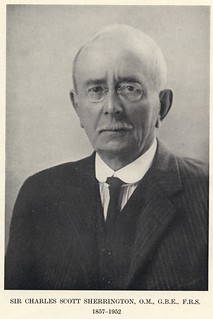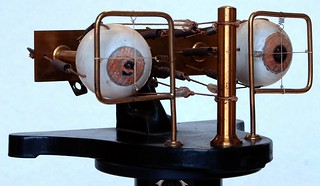- Correspondence Details
-
Sent From (Definite): Sir Charles Scott Sherrington - Liverpool
Sent To (Definite): Harvey Williams Cushing - Baltimore, MDDate: 30 Dec 1908 - Current Holder(s)
-
Transcript:
'I am ashamed at my delay in answering your kind note - which I am releived to see bears no date, to reproach me by staring me out of face now.
I waited until I could look up the notes of the experiments I made on the eye-muscle nerves. I have not published anything further than the reference in Roy. Soc. Proc. of '97. I think that was [the] date. The notes made at the time show that the III and IV nerves were cut in 5 monkeys, & cut at emergergence from brain. The myelinate nerve-fibres in the muscles were looked at, at dates from 12 to 36 days; it was found that the numerous (e.g. 250) myelinate nerve fibres which reach the insertion end of the muscle in every case showed heavy degenreration. A few (e.g. 30 or so) of these were not degenerate: these were all of small calibre. We concluded these must come from Vth or from ciliary or sympathetic. On cutting Vth (this was done only in one case) distal to ganglion no degenerated myelinate fibre was found in any of the eye-muscles. I concluded that the few undegererated fibres in muscle tendon must come from synap. or from ciliary ganglion.
Now the myelinate nerve fibres at insertion end of muscle must be afferent one imagines, many of them hook down into tendon & then return. There I think can hardly be motor
[sketch at bottom of page: 'myelinated nerve fibres']
for one finds their ends by methylene blue method, as figured in [G. Carl] Huber's paper. Besides I could find no plates at ends of muscle.
Your experiments interest me therefore very much. Our results seem as regards IIIrd n. to be squarely opposed. My wounds healed all night & the ext. rectus muscle nerves showed no trace of degen.
What has always kept me back from publishing my results more fully has been the failure to be able to suggest what cells can give origin to afferent fibres in the 3rd nerve. The so called degenerate ganglion does not seem to, for as far as I could see the fibres went clean through it. Are there any sensory type cells in the IIIrd nerve nucleus in the side of & "below iter[?] a IIIiv[?] and IVam[?] ventriculum"? To ascertain this I cut a number of sections of monkey's isthmus region & could not see such cells. I also went to Louvain and looked through [related to Wautier Franscois?] Van Genechten's series of IIIrd nucleus specimens & could not satisfy myself of any clearly sensory cells in IIIrd nucleus: nor could he (I put question to him).
The point is interesting: I will try for my own satisfaction to repeat my observations & see if I get same results. There is some 'Kunstfehler' somewhere, & I suspect it must by of my commission, & not yours. But I do not see where it lies. H.K. Anderson had the ciliary ganglion in one of my specimens & he detected nothing wrong in my operation.
This rigmarole leaves me less room than I meant for expressing our hearty good wished for all fair fortune & happiness to you Mrs Cushing & the children in the coming year. We are all well with best greetings.
Yours sincerely, C.S. Sherrington.
- No links match your filters. Clear Filters
-
Cites
 C.S. Sherrington, 'Further Note on the Sensory Nerves of Muscles', Proceedings of the Royal Society of London 61 (1897), pp. 247-249.
C.S. Sherrington, 'Further Note on the Sensory Nerves of Muscles', Proceedings of the Royal Society of London 61 (1897), pp. 247-249.
Description:'I waited until I could look up the notes of the experiments I made on the eye-muscle nerves. I have not published anything further than the reference in Roy. Soc. Proc. of '97. I think that was [the] date. The notes made at the time show that the III and IV nerves were cut in 5 monkeys, & cut at emergergence from brain. The myelinate nerve-fibres in the muscles were looked at, at dates from 12 to 36 days; it was found that the numerous (e.g. 250) myelinate nerve fibres which reach the insertion end of the muscle in every case showed heavy degenreration. A few (e.g. 30 or so) of these were not degenerate: these were all of small calibre. We concluded these must come from Vth or from ciliary or sympathetic. On cutting Vth (this was done only in one case) distal to ganglion no degenerated myelinate fibre was found in any of the eye-muscles. I concluded that the few undegererated fibres in muscle tendon must come from synap. or from ciliary ganglion.'
















